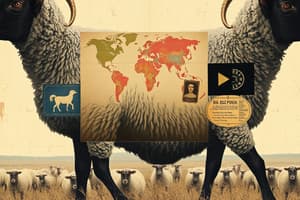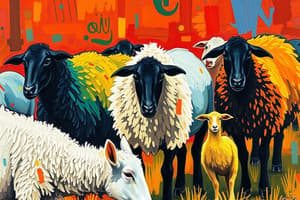Podcast
Questions and Answers
What is the main reason behind phasing out mulesing in New Zealand?
What is the main reason behind phasing out mulesing in New Zealand?
Mulesing was phased out to improve animal welfare and prevent unnecessary suffering to sheep.
What was the impact of crossbreeding Merino sheep from Vermont with Australian Merino sheep?
What was the impact of crossbreeding Merino sheep from Vermont with Australian Merino sheep?
Crossbreeding led to the production of thicker, wrinkled fleeces that made sheep more susceptible to flystrike.
Who is credited with developing the mulesing technique and what was the initial discovery?
Who is credited with developing the mulesing technique and what was the initial discovery?
John Mules is credited with developing the technique after discovering that a sheep's scar tissue did not attract blowflies.
What consequences can arise from flystrike in sheep?
What consequences can arise from flystrike in sheep?
Why do gravid female blowflies prefer laying eggs on certain sheep?
Why do gravid female blowflies prefer laying eggs on certain sheep?
What date marked the official ban on mulesing sheep in New Zealand?
What date marked the official ban on mulesing sheep in New Zealand?
What unintended benefit was observed after John Mules' accidental cutting of a ewe's skin?
What unintended benefit was observed after John Mules' accidental cutting of a ewe's skin?
What historical problem did Australian sheep breeders face that led to the selection of thicker wool?
What historical problem did Australian sheep breeders face that led to the selection of thicker wool?
What is the primary purpose of mulesing in sheep farming?
What is the primary purpose of mulesing in sheep farming?
How does the scar tissue formed from mulesing contribute to preventing flystrike?
How does the scar tissue formed from mulesing contribute to preventing flystrike?
What are some concerns associated with the practice of mulesing?
What are some concerns associated with the practice of mulesing?
What do the National Farmers Federation of Australia's views on mulesing reflect about its necessity?
What do the National Farmers Federation of Australia's views on mulesing reflect about its necessity?
What stance does the Australian Veterinary Association (AVA) take on mulesing?
What stance does the Australian Veterinary Association (AVA) take on mulesing?
What alternatives to mulesing does PETA suggest for preventing flystrike?
What alternatives to mulesing does PETA suggest for preventing flystrike?
What was the commitment made by the Australian wool industry regarding mulesing in 2004?
What was the commitment made by the Australian wool industry regarding mulesing in 2004?
In what way is mulesing specific to certain breeds of sheep?
In what way is mulesing specific to certain breeds of sheep?
Flashcards are hidden until you start studying
Study Notes
Mulesing Overview
- Mulesing involves removing wool-bearing skin around a sheep's breech to prevent flystrike (myiasis).
- Wool around the buttocks can harbor feces and urine, attracting flies that cause flystrike.
- Scar tissue formed from mulesing does not grow wool, reducing the risk of flystrike in that area.
- Commonly performed on Merino sheep in Australia due to their wrinkled skin.
Controversy and Perspectives
- Mulesing is viewed as a skilled surgical practice but remains controversial regarding animal welfare.
- The National Farmers Federation of Australia claims mulesing is essential to prevent high mortality from flystrike (estimated up to 3 million sheep could die annually without it).
- The Australian Veterinary Association acknowledges welfare concerns yet accepts mulesing in the absence of humane alternatives, advocating for pain relief and proper training for practitioners.
- The Royal Society for the Prevention of Cruelty to Animals considers mulesing acceptable only when the risk of flystrike is very high and as a last resort.
Criticism and Alternatives
- PETA and other animal rights organizations oppose mulesing, labeling it as cruel, and promote alternative methods such as special diets and spray washing to avoid flystrike.
Industry Response
- In July 2009, the Australian wool industry reneged on a commitment to phase out mulesing by December 2010.
- New Zealand began a phase-out of mulesing in 2007, with an official ban enacted in October 2018.
Background Context
- The Australian sheep blow fly, an invasive species, poses significant threats to sheep.
- Crossbreeding of Merino sheep in the late 19th century led to the development of more wrinkled and productive fleece, exacerbating flystrike risk.
- The accidental discovery of mulesing occurred in the 1930s when rancher John Mules noted the healing of a sheep's wound without recurrence of flystrike.
- Mulesing involves peeling strips of skin from the sheep’s buttocks using shears, a technique now widely used despite concerns regarding animal welfare.
Studying That Suits You
Use AI to generate personalized quizzes and flashcards to suit your learning preferences.



